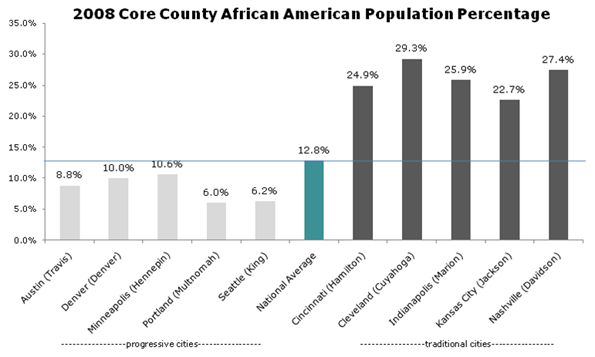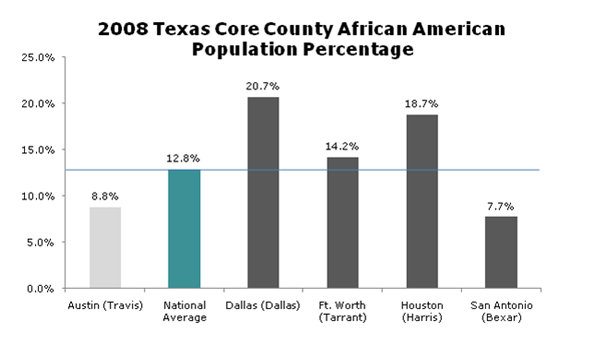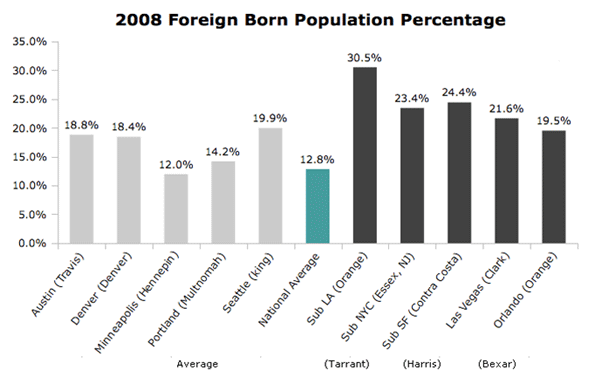
Among the media, academia and within planning circles, there’s a generally standing answer to the question of what cities are the best, the most progressive and best role models for small and mid-sized cities. The standard list includes Portland, Seattle, Austin, Minneapolis, and Denver. In particular, Portland is held up as a paradigm, with its urban growth boundary, extensive transit system, excellent cycling culture, and a pro-density policy. These cities are frequently contrasted with those of the Rust Belt and South, which are found wanting, often even by locals, as “cool” urban places.
But look closely at these exemplars and a curious fact emerges. If you take away the dominant Tier One cities like New York, Chicago and Los Angeles you will find that the “progressive” cities aren’t red or blue, but another color entirely: white.
In fact, not one of these “progressive” cities even reaches the national average for African American percentage population in its core county. Perhaps not progressiveness but whiteness is the defining characteristic of the group.

The progressive paragon of Portland is the whitest on the list, with an African American population less than half the national average. It is America's ultimate White City. The contrast with other, supposedly less advanced cities is stark.
It is not just a regional thing, either. Even look just within the state of Texas, where Austin is held up as a bastion of right thinking urbanism next to sprawlvilles like Dallas-Ft. Worth and Houston.

Again, we see that Austin is far whiter than either Dallas-Ft. Worth or Houston.
This raises troubling questions about these cities. Why is it that progressivism in smaller metros is so often associated with low numbers of African Americans? Can you have a progressive city properly so-called with only a disproportionate handful of African Americans in it? In addition, why has no one called these cities on it?
As the college educated flock to these progressive El Dorados, many factors are cited as reasons: transit systems, density, bike lanes, walkable communities, robust art and cultural scenes. But another way to look at it is simply as White Flight writ large. Why move to the suburbs of your stodgy Midwest city to escape African Americans and get criticized for it when you can move to Portland and actually be praised as progressive, urban and hip? Many of the policies of Portland are not that dissimilar from those of upscale suburbs in their effects. Urban growth boundaries and other mechanisms raise land prices and render housing less affordable exactly the same as large lot zoning and building codes that mandate brick and other expensive materials do. They both contribute to reducing housing affordability for historically disadvantaged communities. Just like the most exclusive suburbs.
This lack of racial diversity helps explain why urban boosters focus increasingly on international immigration as a diversity measure. Minneapolis, Portland and Austin do have more foreign born than African Americans, and do better than Rust Belt cities on that metric, but that's a low hurdle to jump. They lack the diversity of a Miami, Houston, Los Angeles or a host of other unheralded towns from the Texas border to Las Vegas and Orlando. They even have far fewer foreign born residents than many suburban counties of America's major cities.

The relative lack of diversity in places like Portland raises some tough questions the perennially PC urban boosters might not want to answer. For example, how can a city define itself as diverse or progressive while lacking in African Americans, the traditional sine qua non of diversity, and often in immigrants as well?
Imagine a large corporation with a workforce whose African American percentage far lagged its industry peers, sans any apparent concern, and without a credible action plan to remediate it. Would such a corporation be viewed as a progressive firm and employer? The answer is obvious. Yet the same situation in major cities yields a different answer. Curious.
In fact, lack of ethnic diversity may have much to do with what allows these places to be “progressive”. It's easy to have Scandinavian policies if you have Scandinavian demographics. Minneapolis-St. Paul, of course, is notable in its Scandinavian heritage; Seattle and Portland received much of their initial migrants from the northern tier of America, which has always been heavily Germanic and Scandinavian.
In comparison to the great cities of the Rust Belt, the Northeast, California and Texas, these cities have relatively homogenous populations. Lack of diversity in culture makes it far easier to implement “progressive” policies that cater to populations with similar values; much the same can be seen in such celebrated urban model cultures in the Netherlands and Scandinavia. Their relative wealth also leads to a natural adoption of the default strategy of the upscale suburb: the nicest stuff for the people with the most money. It is much more difficult when you have more racially and economically diverse populations with different needs, interests, and desires to reconcile.
In contrast, the starker part of racial history in America has been one of the defining elements of the history of the cities of the Northeast, Midwest, and South. Slavery and Jim Crow led to the Great Migration to the industrial North, which broke the old ethnic machine urban consensus there. Civil rights struggles, fair housing, affirmative action, school integration and busing, riots, red lining, block busting, public housing, the emergence of black political leaders – especially mayors – prompted white flight and the associated disinvestment, leading to the decline of urban schools and neighborhoods.
There's a long, depressing history here.
In Texas, California, and south Florida a somewhat similar, if less stark, pattern has occurred with largely Latino immigration. This can be seen in the evolution of Miami, Los Angeles, and increasingly Houston, San Antonio and Dallas. Just like African-Americans, Latino immigrants also are disproportionately poor and often have different site priorities and sensibilities than upscale whites.
This may explain why most of the smaller cities of the Midwest and South have not proven amenable to replicating the policies of Portland. Most Midwest advocates of, for example, rail transit, have tried to simply transplant the Portland solution to their city without thinking about the local context in terms of system goals and design, and how to sell it. Civic leaders in city after city duly make their pilgrimage to Denver or Portland to check out shiny new transit systems, but the resulting videos of smiling yuppies and happy hipsters are not likely to impress anyone over at the local NAACP or in the barrios.
We are seeing this script played out in Cincinnati presently, where an odd coalition of African Americans and anti-tax Republicans has formed to try to stop a streetcar system. Streetcar advocates imported Portland's solution and arguments to Cincinnati without thinking hard enough to make the case for how it would benefit the whole community.
That's not to let these other cities off the hook. Most of them have let their urban cores decay. Almost without exception, they have done nothing to engage with their African American populations. If people really believe what they say about diversity being a source of strength, why not act like it? I believe that cities that start taking their African American and other minority communities seriously, seeing them as a pillar of civic growth, will reap big dividends and distinguish themselves in the marketplace.
This trail has been blazed not by the “progressive” paragons but by places like Atlanta, Dallas and Houston. Atlanta, long known as one of America's premier African American cities, has boomed to become the capital of the New South. It should come as no surprise that good for African Americans has meant good for whites too. Similarly, Houston took in tens of thousands of mostly poor and overwhelmingly African American refugees from Hurricane Katrina. Houston, a booming metro and emerging world city, rolled out the welcome mat for them – and for Latinos, Asians and other newcomers. They see these people as possessing talent worth having.
This history and resulting political dynamic could not be more different from what happened in Portland and its “progressive” brethren. These cities have never been black, and may never be predominately Latino. Perhaps they cannot be blamed for this but they certainly should not be self-congratulatory about it or feel superior about the urban policies a lack of diversity has enabled.
Aaron M. Renn is an independent writer on urban affairs based in the Midwest. His writings appear at The Urbanophile.













Progressive
I agree that in spoken American English the term progressive refers to leftist.
But progress doesn't mean moving to the left it means progress. Progress and progressive means getting better not more leftist.
I am a bit tired of liberals assuming that they mean progress and the other side doesn't.
A progressive city is a city that is getting better. Could be because of a new right wing mayor investing city funds better.
You Could Say The Same Thing for "The Black City"
Being black from Cincinnati and now living in Austin, reading the "The White City" article is both a validation of demographic observations and sobering testimony of how 21st Century cities are becoming a lifestyle choice where race is just an unintentional adjective, perhaps leading to 'intentional' acts of racial balkanism.
Being raised in Cincinnati, in the '70s my parents moved there because there were an abundance of middle-class blacks that were "doing well". In fact, Cincinnati does have safe "blurbs" (black suburbs). However, my deep criticism of Greater Cincinnati is that the suburban wealthy and middle-class blacks shun the black lower-class in Cincinnati.
In the 2000s, now the black "boom towns" are Atlanta and Houston. Living in Austin, instead of lapping it up in progressive texan shangli-la, I get the creeping sense of being "left behind". Nearly all of my cousins in my young age (20s-30s) have moved to Houston after high school because there is "culture". When I've told my white friends, they look at me with incredulity. They don't understand. But, "old South" may have ended for white Austin, but, after the 60s, it never did elsewhere for black and hispanics, except with a '90s high tech bang with massive white incoming and rising home prices (far beyond average minority incomes).
As a result, Black and hispanic east Austin is dying. The people know it. The city of Austin and its downtown plan expect it. And, cynically, both the young and old minorities suspect, they won't be missed. After all, their positioning in east Austin was a consequence for "old South" segregation. Well, nothing lasts forever, and what the real estate market gave, the market now takes away..and for some young minorities, time to go to a new "promiseland".
For me, I love Austin for the art, "atmosphere" of diversity, progressivism, and civic will to build a denser, more impact urban core. Even though sometimes being only black face in restaurants and stores is a little uncomfortable -and jarring. I want to be a part of that effort against the encroaching suburban "donut hole" ravaging so many of our fine American cities.
Sadly, in some black quarters, the article's mindset simply reveals what many people have thought all along. That, perhaps unconscious - or conscious, race or the lack of race has become a lifestyle choice.
In Texas, Austin for 'liberal' whites. Houston for blacks. Dallas for 'conservative' whites. San Antonio for hispanics. All the while, not dealing, but "dealing", with the issue of race - in its absence.
If it's not done with malicious intent, but it is the result, is it racist? Is it racism at all to go where one feels 'comfortable', even if the faces and viewpoints are all the 'same'?
Please discuss.
Fantastic Comment
I am from San Antonio, went to school in Austin and currently live in New York. When I was in school in Austin, I loved the progressive and educated culture, with its liberal social and environmental ideals. I also remember thinking how weird it was that there were so few black people around. It seemed contrary to the ubiquitous open-minded attitude claimed by everyone.
Attending architecture school, I saw old zoning maps from the 30s of Austin, with "Negro District" clearly marked just east of downtown. It's an open secret that I35 was built in the 60s where it is to further segregate the black neighborhood. East Austin is one of Austin's best neighborhoods, and it's another open secret that yuppies are colonizing it very rapidly. Poorer black people are moving further north near the St Johns area which is farther from jobs, is more dangerous, and has lower quality housing.
With the influx of richer whites to the east side, the city has been investing in the neighborhood, and it will (one day) have one of the only light rail stations in the city. Having never had the opportunity to discuss these obvious changes with a black person while in Austin, I am very glad to hear the obvious truth: it's not as much of a progressive wonderland if you are black.
Being gay, Austin seemed progressive, especially compared to San Antonio. Living in New York, the truth is that people will only treat a group with respect when they have a critical mass of economic and cultural influence, regardless of the stated progressiveness (or lack thereof) in a city. I imagine this is true for black people in Atlanta and Houston. Even though Austinites are probably more liberal than Houstonians when it comes to social and environmental issues, no amount of progressiveness can make up for a group having a critical mass of representation.
I think the article needs to focus more on the size of the economies of these cities and the average income. In a place like Portland or Austin, it isn't just about race. These places are rich. Cleveland, by contrast is poor. White flight isn't really about ethnic segregation, it's about the flight of capital away from the inner city (or in this case, the entire city). I am sure there are may rust belt cities that would love to build light rail systems, but they have to weigh that against increasing taxes on a population that has greater difficulty paying them.
Austin was once a poor town, but grew because of the growth of the state government and the prestige of UT. Austin and Portland promoted policies that attracted the rich. These policies took decades to yield results. Portland started building its train system almost 30 years ago. If we want to revitalize the rust belt cities, the federal government needs to help finance public transportation investment and environmental clean ups that will build the kind of cities all sorts of people will be attracted to. Americans shouldn't have to travel thousands of miles for economic opportunities.
Fantastic Comment
I am from San Antonio, went to school in Austin and currently live in New York. When I was in school in Austin, I loved the progressive and educated culture, with its liberal social and environmental ideals. I also remember thinking how weird it was that there were so few black people around. It seemed contrary to the ubiquitous open-minded attitude claimed by everyone.
Attending architecture school, I saw old zoning maps from the 30s of Austin, with "Negro District" clearly marked just east of downtown. It's an open secret that I35 was built in the 60s where it is to further segregate the black neighborhood. East Austin is one of Austin's best neighborhoods, and it's another open secret that yuppies are colonizing it very rapidly. Poorer black people are moving further north near the St Johns area which is farther from jobs, is more dangerous, and has lower quality housing.
With the influx of richer whites to the east side, the city has been investing in the neighborhood, and it will (one day) have one of the only light rail stations in the city. Having never had the opportunity to discuss these obvious changes with a black person while in Austin, I am very glad to hear the obvious truth: it's not as much of a progressive wonderland if you are black.
Being gay, Austin seemed progressive, especially compared to San Antonio. Living in New York, the truth is that people will only treat a group with respect when they have a critical mass of economic and cultural influence, regardless of the stated progressiveness (or lack thereof) in a city. I imagine this is true for black people in Atlanta and Houston. Even though Austinites are probably more liberal than Houstonians when it comes to social and environmental issues, no amount of progressiveness can make up for a group having a critical mass of representation.
I think the article needs to focus more on the size of the economies of these cities and the average income. In a place like Portland or Austin, it isn't just about race. These places are rich. Cleveland, by contrast is poor. White flight isn't really about ethnic segregation, it's about the flight of capital away from the inner city (or in this case, the entire city). I am sure there are may rust belt cities that would love to build light rail systems, but they have to weigh that against increasing taxes on a population that has greater difficulty paying them.
Austin was once a poor town, but grew because of the growth of the state government and the prestige of UT. Austin and Portland promoted policies that attracted the rich. These policies took decades to yield results. Portland started building its train system almost 30 years ago. If we want to revitalize the rust belt cities, the federal government needs to help finance public transportation investment and environmental clean ups that will build the kind of cities all sorts of people will be attracted to. Americans shouldn't have to travel thousands of miles for economic opportunities.
Tommy, thanks for a very
Tommy, thanks for a very insightful comment - I really appreciate it.
Ummm, what?
Where did you get these statistics and are you aware that if you make claims based on a data point of that "8.8% Travis County residents are African American", then you ought to show the rest of the percentages that add up to 100%.
As it is right now, you are taking a narrow slice out of a large dataset, and using it to making broad generalizations that are completely ignoring entire continents of people.
Aaron- I thought this was a
Aaron-
I thought this was a great article. This is an observation I have made for quite some time, in fact it is one that is noticed by more than you would probably think. In a 20th century US History course I recently took we had a discussion about topics identical to this article. Both black and white students in the class agreed largely with your observation. I live in Tennessee, and I find it interesting that most of the comments that take issue with your article are posted by people living in the cities in question. Now, they might be in a better position to critique or they may just be blindly defensive.... Probably a little of both.
MW
This is the kind of thing
This is the kind of thing that should be used to teach freshman about bad statistics.
What is the definition of a "progressive city?" Is there any quantifiable set of criteria that results in a list of just these five? What is the justification for excluding "Tier One" cities? What is the definition of a "Tier One" city? What is the definition of "Traditional City?"
This, class, is what we refer to a "reliability problem."
Why is "whiteness" indicated as percentage of Af-American? What happened to all the other race/ethnic categories? Why is the NATIONAL avg of Af-American used to define "whiteness" based on COUNTY level data of cities?
This, class, is what we refer to a "validity problem."
I think you basically started with an observation that, "hey, hipsters are white!" and then created a bunch of bar graphs.
Totally agree with the
Totally agree with the comment on bad statistics. There are many other flaws in the argument as well. Chief among them is the very misleading title: why is this called "The White City," when what the author really means is the "Non-Black City?" Is the author suggesting that the U.S. has evolved to a racial paradigm where it's Blacks and everyone else (White, Asian, Hispanic)?
The underlying argument that progressive cities are rooted in a sense of "white flight" from larger cities, is flawed.
1) Does the author consider that because Blacks tend to be poorer, they do not have the means to move to new cities, as other groups do? I bet you would find hordes of Blacks who would prefer the lifestyle of Portland, Denver, or Minneapolis, to Cleveland, Baltimore, or Atlanta.
(also, as others have pointed out, the "traditional" Rust Belt cities are far less racially diverse than the "progressive" cities)
2) How is building light rail an anti-Black policy, as the author suggests? Poorer people tend to live in denser areas and have higher usage of public transporation. And last I checked, plenty of poor minorities and immigrants use bicycles (and would benefit from bicycle-friendly policy) as well.
3)Whites and others move to progressive cities not to get away from blacks, as the author suggests, but because they are more readily able to live out their liberal ideals. "Traditional" cities have more entrenched political systems that make new and progressive policies far more difficult to implement.
"Whites and others move to
"Whites and others move to progressive cities not to get away from blacks, as the author suggests, but because they are more readily able to live out their liberal ideals."
This is complete BS. Everything that is available in white cities is available in cities with major black populations. The politics couldn't be any bluer Democrat. What liberal ideal could you not realize in Detroit? More social programs? Higher taxes? Unionization? Public transit? Educating poor children to improve their futures?
People continue to move from the black cities to the white cities because they don't want to deal with the crime (the inconvenience of avoiding it) and having to constant daily interactions with the poor.
You get tired of seeing teenage mothers swearing at their own children. You get tired of seeing people throw litter on the ground right in front of you. You get tired of seeing every surface covered with tags. You get tired of driving past their houses with collapsing porches and plastic wrap windows.
That's why you move to Portland. So you can walk to a restuarant, then a bar, and walk home without looking over your shoulder or finding your apartment burgularized. We have good bars, restuarants, galleries, and even bike trails in the black cities. And your white cities are chock full of people who grew up here anyway. Its not the presence of yuppies that draws migrants to Denver, Seattle, Portland, and Austin, its the absence of huge, dangerous ghettos.